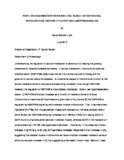Search
Now showing items 1-6 of 6
NADPH Oxidase as a Mechanistic Link Between Erectile Dysfunction, Peripheral, and Coronary Endothelial Dysfunction in Obesity
(East Carolina University, 2012)
Cardiovascular complications involving both microvascular and macrovascular tissues are the major cause of morbidity and mortality in obese patients. Clinical and epidemiological studies suggest that erectile dysfunction ...
Regulation of Lipolysis By Perilipin : influence of Obesity and Exercise Training
(East Carolina University, 2010)
Obesity is the result of excess energy storage due to an imbalance between energy storage and energy utilization. Excess energy is stored as triacylglycerol (TAG) in adipose tissue in various regions throughout the body. ...
IL-15 : A NOVEL REGULATOR OF LIPOLYSIS IN HUMANS?
(East Carolina University, 2014)
Interactions between and within organ systems such as skeletal muscle (SkM) and adipose tissue (AT), via immune cell signaling factors (cytokines), may regulate the development of obesity. The increased expression and ...
NOVEL MECHANISMS GOVERNING SKELETAL MUSCLE MITOCHONDRIAL BIOENERGETICS : OXPHOS EFFICIENCY AND cAMP/PKA SIGNALING
(East Carolina University, 2014)
Understanding the regulation of cellular metabolism is paramount to treating the growing prevalence of metabolic disease worldwide. In cellular metabolism, mitochondrial oxidative phosphorylation (OXPHOS) plays a key role ...
SKELETAL MUSCLE METABOLIC FLEXIBILITY IMPAIRMENTS IN RESPONSE TO LIPID WITH OBESITY : EFFECT OF EXERCISE TRAINING
(East Carolina University, 2012)
Obese individuals exhibit skeletal muscle metabolic inflexibility by failing to increase fat oxidation and genes linked with mitochondrial biogenesis in response to a high-fat diet (HFD) and lipid incubation in cell culture. ...
The Region Specific Influence of Estradiol on In-Vivo Lipolysis in Subcutaneous Adipose Tissue in Overweight-to-Moderately-Obese Premenopausal Women
(East Carolina University, 2012)
Premenopausal women demonstrate preferential accumulation of adiposity in the gynoid region, a distribution which shifts towards the abdominal region after the menopausal transition. Although estrogen is implicated as a ...






